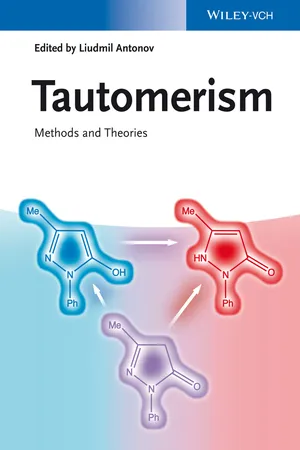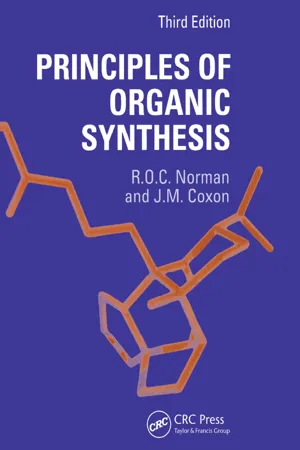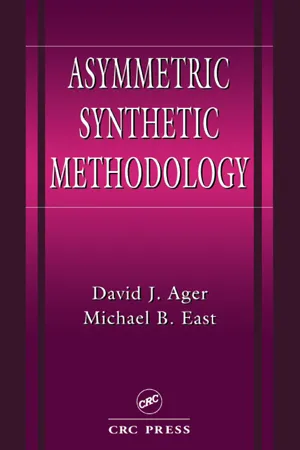Chemistry
Keto Enol Tautomerism
Keto enol tautomerism is a chemical phenomenon where a molecule can exist in two forms, keto and enol, that are in equilibrium with each other. This occurs due to the movement of a hydrogen atom and a double bond between two carbon atoms. The tautomerism is important in organic chemistry as it can affect the reactivity and properties of the molecule.
Written by Perlego with AI-assistance
Related key terms
Related key terms
1 of 4
Related key terms
1 of 3
6 Key excerpts on "Keto Enol Tautomerism"
- No longer available |Learn more
MCAT Organic Chemistry Review 2024-2025
Online + Book
- (Author)
- 2023(Publication Date)
- Kaplan Test Prep(Publisher)
(the en – component) and an alcohol (the – ol component). The two isomers, which differ in the placement of a proton and the double bond, are called tautomers. The equilibrium between the tautomers lies far to the keto side, so there will be many more keto isomers in solution. The process of interconverting from the keto to the enol tautomer, shown in Figure 7.2, is called enolization, or, more generally, tautomerization. By extension, any aldehyde or ketone with a chiral α -carbon will rapidly become a racemic mixture as the keto and enol forms interconvert, a phenomenon known as α -racemization. Figure 7.2. Enolization (Tautomerization) On the left is the keto form, which is thermodynamically favored over the enol form on the right. KEY CONCEPT Aldehydes and ketones exist in the traditional keto form (C=O) and as the less common enol tautomer (enol = ene + ol). The deprotonated enolate form can act as a nucleophile. Note that tautomers are not resonance structures because they differ in their connectivity of atoms. Enols are important intermediates in many reactions of aldehydes and ketones. The enolate carbanion results from the deprotonation of the α -carbon by a strong base, as described earlier. Common strong bases include the hydroxide ion, lithium diisopropyl amide (LDA), and potassium hydride (KH). A 1,3-dicarbonyl is particularly acidic because there are two carbonyls to delocalize negative charge and, as such, is often used to form enolate carbanions. Once formed, the nucleophilic carbanion reacts readily with electrophiles. We will see one example of this shortly in the aldol condensation - Paulo Costa, Ronaldo Pilli, Sergio Pinheiro, Peter Bakuzis(Authors)
- 2022(Publication Date)
- Royal Society of Chemistry(Publisher)
3 because the carbonyl group in esters is also involved in cross-resonance with the lone electron pair of the oxygen atom of the alkoxy group. We will see throughout this book that some chemical properties of aldehydes and ketones are due to the participation of the enol forms.Scheme 2.3 Keto–enol tautomerism in aldehydes, ketones, and imines.Enolization in Aqueous Media
In aqueous solution, calculations suggest that two to three water molecules are involved in the enolization of carbonyl compounds, acting both as acids and bases. The reaction mechanism has been studied by DFT calculations for acetylacetone in an aqueous environment and it has been shown that a hydrogen bond lattice of three water molecules stabilizes the enolization transition state, leading to a lower activation energy barrier. Among the possible arrangements, the one below was shown to have the lowest energy barrier.Enolization is a slow process in neutral solution, but it can be accelerated under acid or base catalysis. Ketones are considered to be more basic than aldehydes regarding protonation of the carbonyl oxygen (pK a −8 and −5, for the conjugate acids of acetaldehyde and acetone, respectively) and they undergo acid-catalyzed enolization. In diluted aqueous perchloric acid, the enolization constant for acetaldehyde was determined to be 5.0 × 10−7 , while for acetone it is 4.7 × 10−9 , showing the predominance of the keto form under these conditions. The equilibrium constant for the dissociation of Hα in aqueous solution was shown to be 3.2 × 10−17 and 7.9 × 10−20- eBook - ePub
Tautomerism
Methods and Theories
- Liudmil Antonov(Author)
- 2013(Publication Date)
- Wiley-VCH(Publisher)
This happens in 12 (Figure 1.4), where, compared to the parent compound 13, the intramolecular hydrogen bonding between the tautomeric OH group and the basic nitrogen from the side arm leads to the disappearance of the keto tautomer [12, 13]. The situation changes upon protonation (or complex formation) – the basic nitrogen is protonated and a new hydrogen bonding, this time between protonated sidearm and tautomeric carbonyl group, shifts the equilibrium toward the keto form 12H +. In this way, by changing pH (or salt concentration) of the solution, controlled shift in the position of the enol–keto equilibrium can be achieved. Unfortunately, the efficiency of the switching system crucially depends on tautomerism in the parent skeleton: it works in the case of the azonaphthols 13 and 14 [14] and the heterocyle 15 [15], but does not in azophenol 16 or azoanthranol 17, where the tautomeric equilibrium is strongly shifted a priori. The replacement of the side arm, as it is in 18 [16] and 19 [17], does not stabilize the enol tautomer because of keto dimer formation (18) or double hydrogen bonding stabilization of the keto tautomer (19). Figure 1.4 Intramolecular hydrogen bonding with a side chain group. 1.5 Changes in Tautomeric Form Brought About by Electronegative Substituents This problem, which is specially prominent in oxoheterocycles, is caused largely by the effect of electronegative substituents in engineering a switch from the oxo to the less polar hydroxyl tautomer. There is little good documentation on this subject in the literature so we have generated our own [4]. The type of equation we have tried, and which works well enough to be provisionally worth pursuing, typically takes the following form: 1.3 where is that of the parent oxoheterocycle, refers to that resulting from substitution, and lists the relevant -values for the substituent, of which there may be more than one. We have so far distinguished four situations, each with its own governing equation - eBook - ePub
- Marc Descamps(Author)
- 2016(Publication Date)
- Wiley-VCH(Publisher)
Chapter 7 Tautomerism in Drug DeliveryZaneta Wojnarowska and Marian PaluchAccording to common knowledge, tautomerism is observed when one chemical compound is represented by two or more molecular structures that are related by an intramolecular movement of hydrogen between different polar atoms and the rearrangement of double bonds [1]. The most commonly observed examples of this phenomenon are reversible transformations between ketone and enol, amide and imidic acid, lactam and lactim, or enamine and imine forms. On the other hand, the tautomeric reactions in which the heterocyclic ring is opened and closed is usually called ring–chain tautomerism or mutarotation in the case of carbohydrates chemistry.Tautomerization attracts the attention of scientists from many disciplines, including physics, organic and biochemistry, and pharmaceutical science. It is of great importance especially in drug industry because there are a number of active pharmaceutical ingredients (APIs), biopharmaceuticals, and chemical excipients (e.g., saccharides) that readily convert into other isomers when their crystalline structure is lost. According to the literature data, 26% of commercially available APIs reveal the ability to exist in more than one chemical form (Figure 7.1 ) [2].Adapted from Martin [2]. Reproduced with permission of Springer.Frequency distribution of tautomers of a marketed drug.Figure 7.1 - eBook - ePub
- Richard O.C. Norman(Author)
- 2017(Publication Date)
- Routledge(Publisher)
It is capable of wide variation in the reactants and providing regiochemical control and, in some cases, stereochemical control. It consists of the reaction between two molecules of aldehydes or ketones, which may be the same or different: one molecule is converted into a nucleophile by forming its enolate in basic conditions or its enol in acidic conditions (p. 256) and the second acts as an electrophile. The reaction takes its name from the trivial name of the product of the dimerization of acetaldehyde discovered by Wurtz in 1872: The mechanism of the base-catalyzed reaction is as follows: The equilibrium constant for the formation of aldol is 400 m −1. The kinetics (rate = k [CH 3 CHO][OH − ]) show that the first step, generation of the enolate, is rate-determining. In a closely related case, however, the self-condensation of acetone to give diacetone alcohol, the kinetics (rate = k [CH 3 COCH 3 ] 2 [OH − ]) show that the rate-determining step is the reaction of the enolate with a second molecule of acetone: The difference is attributed to the fact that the carbonyl group in acetone is less rapidly attacked by nucleophiles than that in acetaldehyde, partly because the electron-releasing character of methyl compared with hydrogen renders the adduct from acetone (and the preceding transition state) less stable, and partly because the carbonyl group in acetone is more hindered. It is a general feature of aldol reactions that the step involving C—C bond-formation is facilitated by electron-attracting groups on the carbonyl component and retarded by electron-releasing groups. Other general features of the reaction which must be borne in mind in synthetic applications are the following. (1) Reaction is readily reversible, and the position of equilibrium is not always favourable to the product. For example, this is true for the formation of diacetone alcohol from acetone (K = 0.04 m −1) and a special experimental procedure is used to obtain a high yield of the product - eBook - ePub
- David John Ager, Michael B. East(Authors)
- 2020(Publication Date)
- CRC Press(Publisher)
The chemistry of chiral bases, especially with regard to enolate formation, continues to expand. A section in this chapter discusses the general usage of this approach and its closely related asymmetric protonation methodology.5.1. ENOL ETHERS AND ENOLATE FORMATION
The chemistry of enol ethers and enolate formation are closely related as the preparation of the former often proceeds by way of the latter. As we are concerned with asymmetric methodology, there will be little discussion of the chemistry of enols, as their formation and reactions are often under thermodynamic control — although this can be useful in cyclic systems.1The specific formation of an enolate from a carbonyl compound is not a trivial task; regiochemical control has to be exercised, as well as stereochemical. This usage of a masked or control group often requires additional transformations that detract from synthetic eloquence or result in scale-up problems. Sometimes, these factors are simpler to control in cyclic systems, and this has been put to elegant usage in Woodward’s synthesis of erythromycin where cyclic sulfides were used as masked alkyl substituents on an acyclic chain so that the chemistry of the cyclic system could be exploited to control stereochemistry [13.4].2 ,3 ,4 ,5Deprotonation of the carbonyl substrate with a hindered base, such as LDA, usually ensures formation of the kinetic enolate.6 ,7 ,8 ,9 ,10 ,11 ,12 ,13 ,14 ,15 ,16 ,17 ,18 ,19 ,20The use of low temperature eliminates problems due to self condensation of the carbonyl compound.21 Reaction of (S)-3-methyl-2-pentanone with LDA proceeded with deprotonation at the less hindered methyl group; less than 10% racemization occurred.22 The kinetic enolate can be trapped in situ by generation in the presence of trimethylsilyl chloride.23
Index pages curate the most relevant extracts from our library of academic textbooks. They’ve been created using an in-house natural language model (NLM), each adding context and meaning to key research topics.
Explore more topic indexes
Explore more topic indexes
1 of 6
Explore more topic indexes
1 of 4





